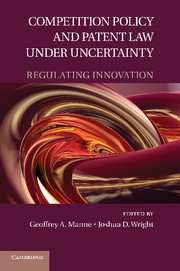Book contents
- Frontmatter
- Contents
- Contributors
- Introduction
- PART I THE INSTITUTIONS OF GROWTH
- PART II THE ECONOMICS OF INNOVATION
- 3 Bundling and Unbundling in New Technology Markets
- 4 Unlocking Technology
- 5 Creative Construction
- PART III INNOVATION AND COMPETITION POLICY
- PART IV THE PATENT SYSTEM
- PART V PROPERTY RIGHTS AND THE THEORY OF PATENT LAW
- PART VI INTELLECTUAL PROPRETY AND ANTITRUST: THE REGULATION OF STANDARD-SETTING ORGANIZATIONS
- Index
- References
3 - Bundling and Unbundling in New Technology Markets
Seven Easy Pieces: The Ideal Is the Enemy of the Efficient
Published online by Cambridge University Press: 05 June 2012
- Frontmatter
- Contents
- Contributors
- Introduction
- PART I THE INSTITUTIONS OF GROWTH
- PART II THE ECONOMICS OF INNOVATION
- 3 Bundling and Unbundling in New Technology Markets
- 4 Unlocking Technology
- 5 Creative Construction
- PART III INNOVATION AND COMPETITION POLICY
- PART IV THE PATENT SYSTEM
- PART V PROPERTY RIGHTS AND THE THEORY OF PATENT LAW
- PART VI INTELLECTUAL PROPRETY AND ANTITRUST: THE REGULATION OF STANDARD-SETTING ORGANIZATIONS
- Index
- References
Summary
Bundling and tie-in sales are well-worked topics in both economics and law. Economists have largely answered the claim that tying the purchase of a monopolized good to a variable quantity of some other good does not readily provide the owner of the first monopoly with rents from a second monopoly. Only under very limited circumstances can a tie-in create a new monopoly. Beyond that, economists have hatched some clever theories that explain why firms might nevertheless engage in tie-in sales. Some of these explanations find that tie-ins can be socially harmless, harmful, or beneficial but nevertheless not monopolizing. Economists have also turned their attention to bundling. Most of these examinations try to explain conditions whereby bundles might increase profits.
In law, tie-in sales were made illegal under section 3 of the Clayton Act in instances where they would tend to create a monopoly. Since then, doctrines developed in case law now extend the provisions of the Sherman Act to tie-in sales, expanding awards and easing the burden of proof by making tie-in sales a per se violation of the law once certain threshold conditions are met. Tie-ins and bundles have also long been addressed by patent abuse doctrines, and most recently they are under attack under telecommunications regulation.
- Type
- Chapter
- Information
- Competition Policy and Patent Law under UncertaintyRegulating Innovation, pp. 77 - 119Publisher: Cambridge University PressPrint publication year: 2011
References
- 3
- Cited by



